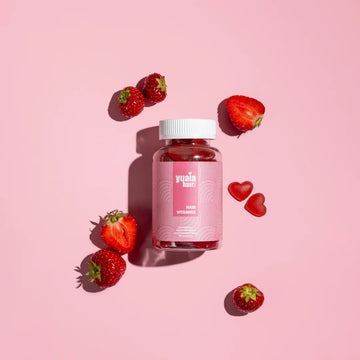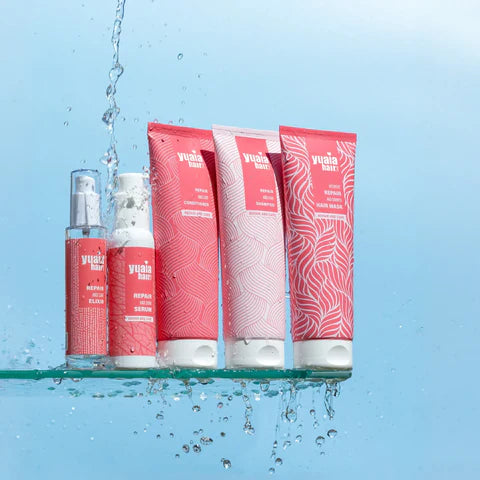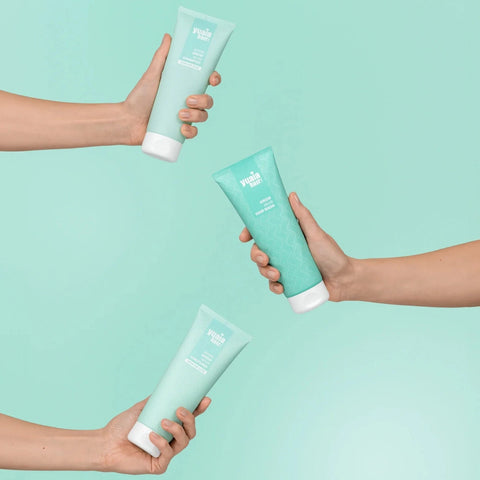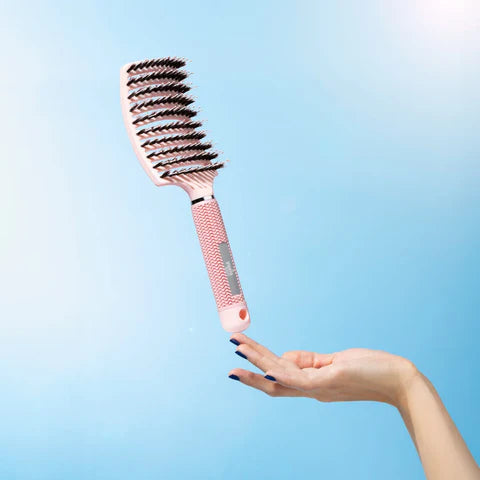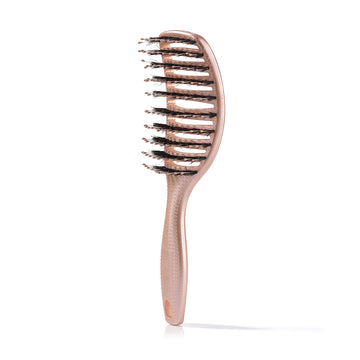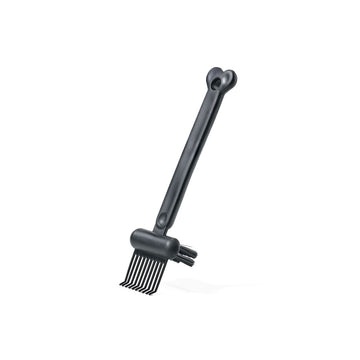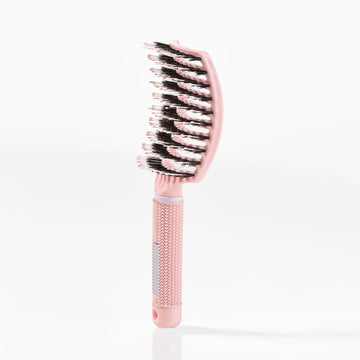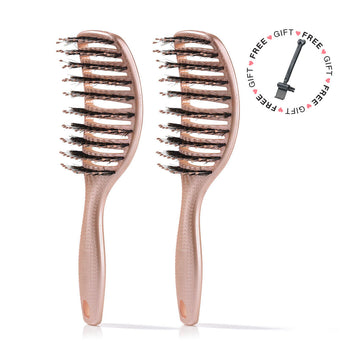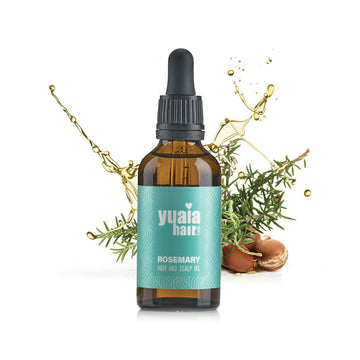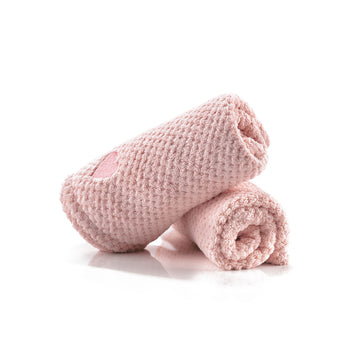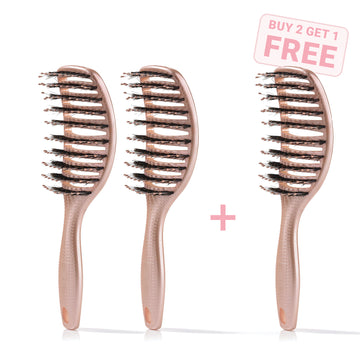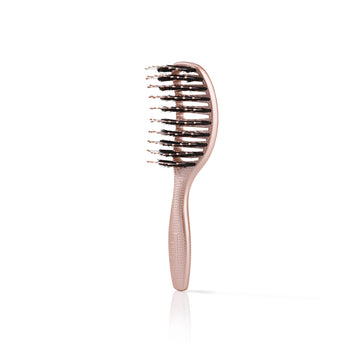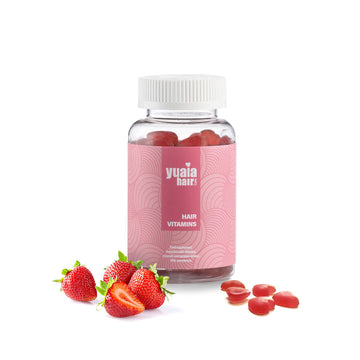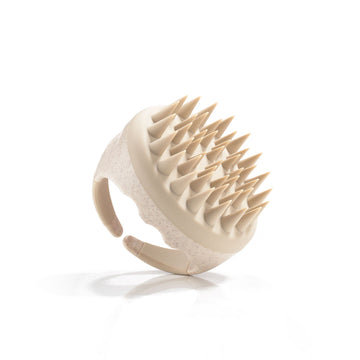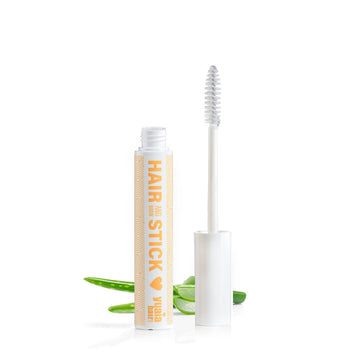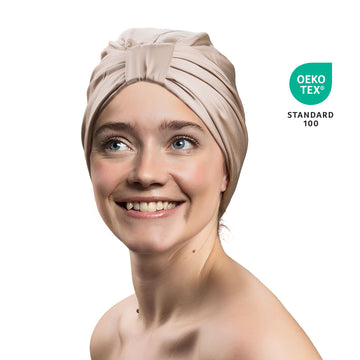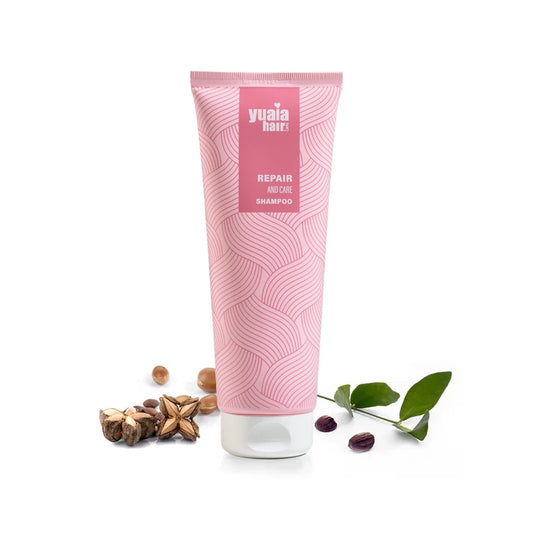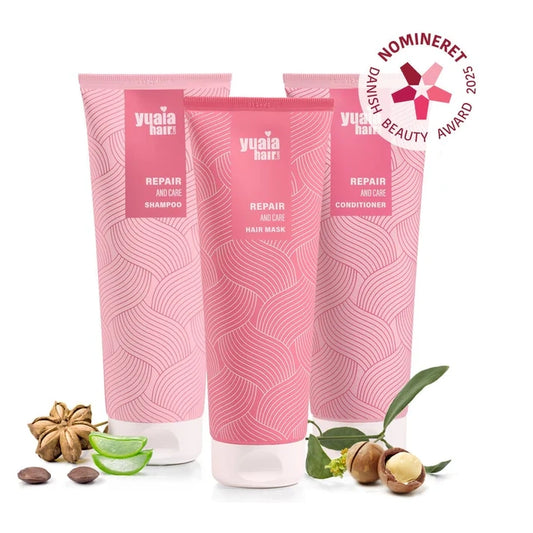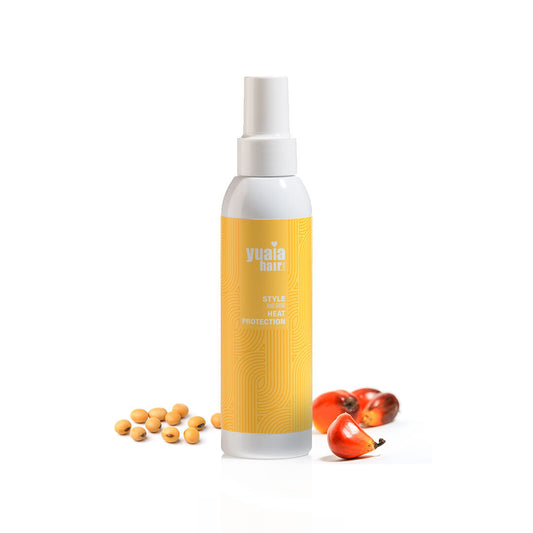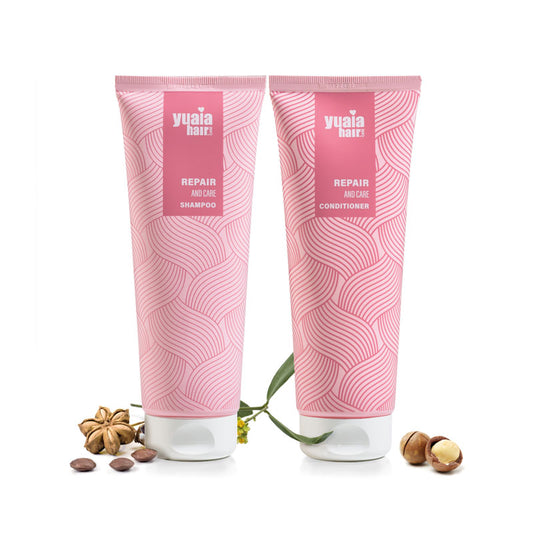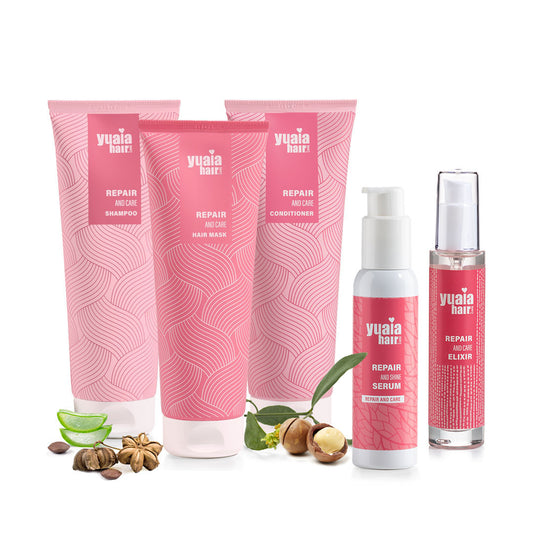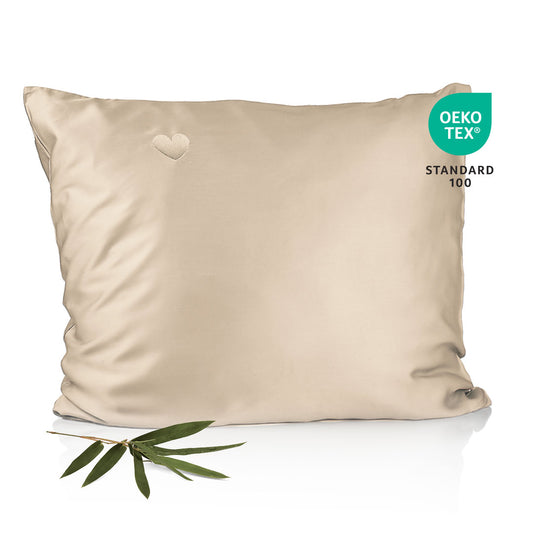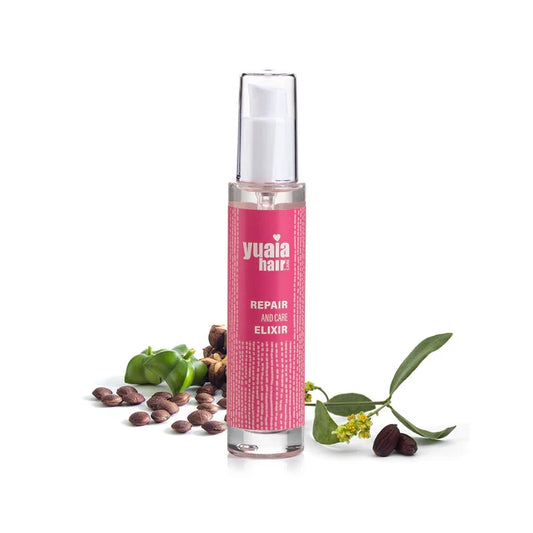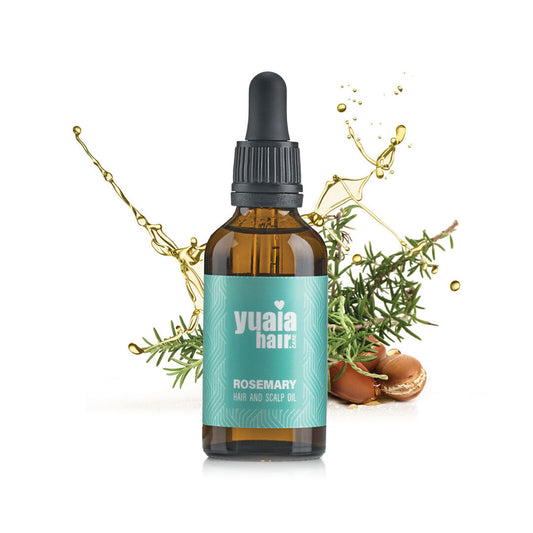Finally, don't take for granted if you always have healthy and shiny hair! It is a rarity, as most of us are all too familiar with having dry, frizzy and lackluster hair. Fortunately, it is also only for periods, but why does our hair actually become dry and frizzy and what can we do to avoid or reduce it? We will try to explain that in this blog post, so that you can hopefully avoid vulnerable and uncooperative hair.
If you want to join the fight against dry and frizzy hair, then read on here - there are many things you can do to get enviable dream hair.
What is dry hair?
Dry hair is a common problem that occurs when your hair doesn't receive or retain enough moisture. This can make hair dull, coarse, hard to manage and often accompanied by frizz, making styling a daily challenge. The causes of dry and frizzy hair vary from environmental factors such as exposure to sun and wind that dry out the hair, to personal hair care habits such as overuse of heat styling tools and chemical treatments that degrade the hair's natural moisture barrier.
Frizzy hair occurs when the moisture in the air penetrates the outer layers of the hair, causing the hair to swell and become unruly. This problem becomes even more pronounced if the hair is already dry, as a dry hair has a swollen and damaged cuticle, making it easy for external moisture to penetrate.
Understanding the causes of dry and frizzy hair is important in order to choose the right care products and routines to restore moisture, smooth the outer layers of the hair and restore your dry and frizzy hair to its natural shine and softness. This includes using moisturising shampoos, conditioners and deep conditioning treatments, and minimising the use of heat styling and chemicals. By taking these steps, you can effectively combat dryness and reduce frizz, leading to healthier, more manageable hair.

Hair types and porosity
Hair types vary from straight to curly hair, each with unique characteristics that affect how they handle moisture and thus their tendency to become dry and frizzy. Straight hair allows easy moisture movement up and down the hair, making it less prone to dryness and frizz, but not immune. Wavy and curly hair tends to become drier and more frizzy as their twisted shape makes it harder for natural oils from the scalp to travel down the hair shaft.
Hair porosity refers to the hair's ability to absorb and retain moisture. You can determine your hair porosity by the simple float or sink test with a strand of hair in a glass of water; hair that sinks immediately has high porosity, while hair that floats has low porosity. Low-porous hair has a dense cuticle that makes it challenging to absorb moisture, but once the moisture is in, it's held inside. High-porosity hair absorbs moisture quickly but struggles to retain it, leading to dryness and frizz.
To effectively care for dry and frizzy hair, it's important to choose products and routines that match your hair type and porosity. Low-porosity hair benefits from light oils and moisturising products that don't weigh hair down. High-porosity hair benefits from heavier, nourishing treatments that help seal the moisture within the hair shaft.
Try our hair test
The hair test gives you precise answers about which products are best for your hair type. Try it now 👇🏼
Try it now!
Why is my hair dry and frizzy?
Unfortunately, there is no one answer to why dry and frizzy hair occurs.
Dry hair and frizzy hair often go hand in hand because both conditions stem from a lack of moisture. When hair lacks sufficient moisture, it becomes dry, which increases the chance that you will also experience frizz, especially in humid conditions. This dual problem requires a careful approach to hair care that addresses both moisturising and combating frizz.
The reasons can be many and it is completely individual what exactly makes your hair dull. Generally speaking, if the hair is dry or has been damaged, then the outermost layer of the hair shaft will be open and have a rough surface. If one's hair is open, it will quickly become dry and frizzy, as the moisture is not sealed in the hair. Dry and frizzy hair is the hair's sign that it lacks moisture and protein. Dry and frizzy hair can show itself in many different ways, for example electric hair, frizzy hair or split ends. Especially people with curly hair can experience dry and frizzy hair. This is because the hair has a different structure, which often becomes dry and frizzy.
We have collected here some of the common denominators we experience that can be culprits for dry and frizzy hair:
Reason 1: Do you have curls?
If you have curly hair, you must have experienced that your hair can feel rough on the surface? This is because curly hair has a greater risk of becoming dry and frizzy, as it needs extra moisture to be in balance. Therefore, if you have curly hair, it is important to pay particular attention to using products intended for curly hair, so that there is a focus on extra moisture. We find that a lot of people are happy with the Curly Girl Method , which is a method that describes which ingredients your products contain and how you should generally take care of your hair so that your curls can thrive and be healthy. You can read more about the Curly Girl Method here .

Reason 2: The effect of the weather on your hair
Although it sounds a bit strange, the weather actually affects your hair quite a bit. It is especially around the changing seasons that we feel big fluctuations, as the hair then has to adapt to a new temperature, humidity, etc.
High humidity can cause frizzy hair to become even more unruly, while dry weather can further dry out hair, making it necessary to tailor care for each hair type in different weather conditions. Effective hair care therefore requires an understanding of how these conditions specifically affect your hair, so you can implement appropriate solutions to maintain hair health and appearance all year round.
In general, cold, frost, wind, sun, heat, salt water and chlorine will wear down the hair, so it is important to prepare the hair for various challenges that come up during the year. In summer, the sun's hot rays will dry out the hair and make it vulnerable. If the hair is not to break, it is therefore important to ensure that it is supplied with a lot of moisture and care. In winter, you also have to protect your hair from the cold and harsh weather, and you have to be especially careful with wet hair outside in the cold months. When the hair is wet, it is most vulnerable.
Reason 3: Do you take hot baths?
Are you one of those people who take a bath in scalding hot water? We all know it; such a cold autumn/winter day where you have little ones frozen all day. There is nothing better than standing at home under the hot shower and being thawed out! But, if you want to take care of your hair (and skin), then you should reconsider the scalding hot bath. The hot water will dry out the hair so that the strands become rough and open. If you don't moisturise your hair afterwards, you risk dry and frizzy hair.
This does not mean that you need to jump out like a winter bather, but try to see if you can wash your hair in as cold water as possible! Lukewarm water can be a middle ground, but remember that even 'hot' water is better than 'burning hot' water.

Reason 4: You are using the wrong shampoo
As described earlier, hair is most vulnerable when it is wet. Therefore, it is incredibly important to use a good shampoo with healthy ingredients that add moisture and care to the hair. Unfortunately, there are many shampoos on the market that contain ingredients that are bad for the hair, even though they promise gold and green forests. Often it is about a 'quick-fix', where the hair immediately looks delicious after use, but in reality, the product just causes dry and frizzy hair. It can, for example, be if the shampoo contains drying alcohol, silicone or harsh sulfates.
REMEMBER: not all alcohols or sulfates are bad. You must, among other things, avoid: ethanol, SD alcohol, SD alcohol 40, Denatured alcohol, propanol, propyl alcohol and isopropyl alcohol, as these can have a drying effect on both hair and skin. Your shampoo should preferably contain: Cetyl, Stearyl and Cetearyl alcohols, as they are fatty alcohols extracted from plants and super good for dry and frizzy hair, as they reduce drying and damage to the hair. So pay attention to which alcohols your shampoo (and products in general) contain! In addition, you must pay attention to choosing an SLS/SLES-sulfate-free shampoo.
Explanation: sulfate is used to clean the scalp and hair. Some sulfates are just too 'harsh' and overcleanse the scalp, washing away the hair's natural oils. In this way, the hair becomes dry and/or you quickly get greasy hair , as the scalp tries to compensate by overproducing the natural oils. Instead, choose a shampoo that is based on glycerin. Glycerin has a moisture-retaining property and forms a protective shield on the hair so that it can better retain moisture and thereby prevent frizz. Later in the blog post, I will come up with suggestions for the best products for dry and frizzy hair, where I, among other things, describes a sulfate-free shampoo.
The best shampoo for dry and frizzy hair
Reason 5: You often use heat styling
It's probably also a culprit we can all nod in recognition of... It's nice when the hair just sits SPOT ON, either because you've blow-dried, straightened or curled it. Styling tools like flat irons, curling irons and hair dryers can apply extreme heat to the hair, stripping away the moisture and leaving you with dry and frizzy hair. Using these tools regularly without protection can lead to heat damage, altering the hair structure and making it even more susceptible to dryness and frizz.
Although it leaves your hair looking sleek and shiny, it's very damaging and drying to the hair. The best thing you can do is not to use heaters, but if that's unrealistic, the next best thing is to remember heat protection spray and set your heaters to the lowest possible temperature that will still give you the desired results. It makes a huge difference and you can also use heat protection spray in the summer when you're outside in the sun.
Alternatives to heat styling include air-drying, using rollers for curls, or experimenting with 'no-heat' hairstyles like braids or twists that can shape hair without damage.

Reason 6: general poor hair care
The most frequent cause of dry and frizzy hair is often that you treat your hair too badly, don't use the right products and don't take care of it enough. Maybe you use some products that don't work for your hair. It can, for example, be products that contain silicone, which acts a bit like a quick-fix, as it leaves the hair shiny and soft, but seals the hair so that it cannot absorb moisture. In this way, you end up in a vicious spiral, where the hair finds it more and more difficult to get care and moisture. Often you don't take care of your hair often enough either. Some have great success with oiling the ends of their hair daily, while others can make do with less. So you have to be very attentive and constantly look and feel your hair for what it needs.
Products for dry hair
You can do this to avoid dry and frizzy hair
To avoid dry and frizzy hair, it's important to understand how different climates affect hair. In humid areas you are more likely to have frizzy hair, while dry climates can strip away moisture and leave you with dry hair. Protecting your hair from these climatic influences requires specific care. For example, using moisturising and anti-frizz products can help maintain hair health and appearance in varying climate conditions. By choosing products and care routines that are adapted to both your hair and the environment you're in, you can effectively minimise problems with dry and frizzy hair.
Since unfortunately most of us suffer from dry and frizzy hair at times, we know that you can feel a little lost in which advice to follow and which products are best... In this section, we give you a guide with good tips and tricks on how you can reduce dry and frizzy hair. Go through the list and see if you are already doing everything that is recommended:
Tip 1: Get your hair cut regularly
Worn and split ends must be cut off, otherwise they can cause the hair strands to break and fray. You can easily tell if your ends are split by looking for small light splits on the surface of the bottom hair. If one's hair is split, it will also break very easily, which you cannot control and can therefore feel like your hair is not growing. We recommend that you approx. get the ends cut every three months, as healthy and well-kept ends are crucial for the overall quality of the hair. If your hair is very sensitive in humid climates, it may be a good idea not to cut your hair in layers. Instead, let the hair have the same length, so that it weighs down and does not frizz up as easily.

Tip 2: Use a shampoo and conditioner for dry hair
As mentioned earlier, you must be aware of what your products must contain if you want to combat dry and frizzy hair. Drying alcohol, silicone and sulphate should be avoided. You must therefore find a shampoo and conditioner that has been developed with the aim of being particularly moisturizing and caring. We recommend Repair and Care Shampoo + Conditioner , which is nurturing, moisturizing and protective. It is important that you ALWAYS remember to use conditioner, as its property is to seal moisture in the hair and subsequently close the hair strand after being cleaned. A conditioner has the task of leaving the hair soft, well-groomed and protected from possible damage. REMEMBER when you wash your hair, be careful with the heat as it is drying. And please stick to washing your hair 2-3 times a week.
Tip 3: Do you remember to use a hair mask?
You can quickly forget to give your hair extra love with a hair mask in a busy everyday life. It's still a really good idea, as a hair mask gives the hair intense care, moisture and nourishment, and since it has to sit in the hair for a long time, it can penetrate deep into the hair. Often, a hair mask can even repair minor surface damage to the hair, so that the hair is less split and frayed. We recommend the Intensive Repair and Growth Hairmask and like to use it once a week. REMEMBER: when you use a hair mask, the order is shampoo, hair mask and finally conditioner. Many people use the hair mask at the end, but since the shampoo opens the hair and the conditioner closes it, you must apply the hair mask in between so that it can penetrate the hair as best as possible.
We have made a whole guide to hair treatments for dry hair here.
Tip 4: Dry your hair in the best way
After you have washed your hair, take extra care while it is still wet. If you are used to using a normal cotton towel, where you twist and shake your hair around, then you should stop! It wears and damages the hair when it is most vulnerable. Instead, you can use a towel that has been specifically developed to dry and protect the hair. We recommend a Microfiber Towel, which is incredibly effective at absorbing water. It is small and light so it does not weigh down your head and neck. It is fastened with a small elastic band around a button at the neck, so that it stays in place (even if you dance wildly in front of the mirror, hihi).

Tip 5: Consider changing the pillow cover
Do you wake up with frizzy hair?? Then maybe it's because you sleep restlessly and mess up your hair on your cotton pillowcase. An alternative can be a bamboo pillow cover, which has much less fabric fibers than cotton. In this way, it is gentler on both hair and skin to sleep on bamboo material, as it leaves much smaller marks. In addition, the material is anti-bacterial and temperature-regulating, so it is always cool and comfortable to lie on. We recommend our Bamboo Pillowcase . Bonus tip: never go to bed with wet hair, as the hair will then be wet for longer than necessary. In addition, it's just boring to sleep on a wet pillow..
Tip 6: How often do you use hair oil?
If you have dry and frizzy hair, most hair can tolerate hair oil every day, but do we remember that? It can be difficult to remember, but try if you can. Many have good experiences with applying a little oil in the morning and evening to the ends of the hair. Others have success applying fairly large amounts in the evening which can then penetrate throughout the night. There are also some whose hair doesn't need oil as often as it gets saturated quickly. Regardless, hair oil for dry and frizzy hair is often a miracle remedy, as it is quickly absorbed into the hair and gives the hair moisture, care and shine.
Tip 7: Braid your hair when you go to sleep
We use approx. a third of our lives spent sleeping. That is why it is also quite important that we take care of our hair while doing it! If you don't like putting your hair up in a messy bun, we can definitely recommend that you stop! Maybe you suffer with small baby hairs on the neck and forehead - that's why. A messy bun wears on the hair so that it breaks at the elastic. Therefore, you should instead braid your hair loosely at the nape of your neck. The benefit is also that you minimise your chance of waking up with frizzy hair and then you will have beautiful natural waves, so you don't have to start the curling iron (win win).
Tip 8: Don't forget the scalp
A healthy scalp is an important prerequisite for healthy hair, as a direct correlation between scalp wellness and hair quality exists. Issues such as dry scalp, dandruff and scalp dermatitis can have a significant impact on the moisture level and structure of the hair. A dry scalp can lead to a lack of necessary oil production, which is needed to keep hair moisturised and supple, while dandruff and scalp dermatitis can cause inflammation. This disrupts hair follicles, which negatively affects hair growth and overall health.
Maintaining a healthy scalp to promote healthier and less frizzy hair requires a conscious choice of the right products. It's important to choose a mild shampoo and other hair care products that are designed for your specific scalp type. Products with harsh chemicals should be avoided as they can further irritate the scalp.
How do I care for my hair based on the season?
Caring for dry and frizzy hair requires attention throughout the year, but the approach should be customised to the specific challenges of the season. Each season brings unique environmental conditions that can affect your hair in different ways. Here's a guide on how to best care for dry and frizzy hair throughout the seasons.
Spring:
Spring can often bring humid weather, which can exacerbate frizz. To combat this, focus on light moisturising products that don't weigh hair down. Consider a leave-in conditioner or a moisturising hair serum to help keep frizz under control. This is also a great time to begin regular deep conditioning treatments to repair any damage caused by winter's dry air.
Summer:
Summer often brings strong sun, salt water and chlorine, all of which can further dry out hair and increase frizz. Protect your hair from the sun by wearing hats or using hair products with UV protection. After swimming in the pool or ocean, rinse your hair with fresh water as soon as possible to remove chlorine and salt. Apply a deep hydrating mask weekly to restore moisture and life to your hair.
Autumn:
Autumn can bring changing weather conditions that fluctuate between hot and cold, which can confuse your hair care regime. Reinforce your routine with nourishing oils, such as argan or jojoba, to lock in moisture and protect against the cooler weather. This is also a great time to trim your hair to remove summer damage and prevent split ends.
Winter:
Winter's dry and cold air is notoriously harsh on dry and frizzy hair. Intensify your moisturising routine by switching to a heavier conditioner and applying leave-in treatments or hair butters that can offer extra protection from the harsh elements. Also consider using a humidifier in your home to combat the dry indoor heat and keep your hair (and skin) from getting too dry.

Diet and hydration also play an important role
Diet and hydration play an important role in maintaining healthy, moisturised hair and reducing the chance of frizz. Water intake is fundamental to the health of the entire body, including the hair. A well-hydrated body can better support healthy hair growth and prevent dryness.
Nutrients such as omega-3 fatty acids, vitamins A, C, E, zinc, and biotin promote hair health. These are found in foods such as fish, nuts, avocados, and green leafy vegetables. A well-balanced diet containing these elements can help strengthen hair from within and reduce the risk of dryness and frizz.
Guide to choosing hair accessories and adornments to avoid dry hair
When dealing with dry and frizzy hair, it's important to choose hair accessories that won't further damage or aggravate the condition. Here are some key points and tips to ensure that your choice of hair accessories contributes positively to the health and appearance of your hair.
Tip 1: Choose soft materials
Look for hair accessories made from soft, smooth materials that won't catch or tear your hair. Fabric-based hair ties, especially those made from satin or silk, are ideal as they reduce friction and therefore the risk of breakage and frizz. These materials help retain the hair's natural moisture, unlike rubber or plastic elastic bands that can pull and damage the hair.
Tip 2: Silk headscarves and pillows
Silk scarves are not only stylish but also functional for those with dry and frizzy hair. They can be used to protect hair from the elements, especially on windy or sunny days. At night, sleeping with a silk pillowcase or a silk headscarf can reduce friction that causes frizz and dryness, helping to preserve hairstyles longer.
Tip 3: Use non-pulling hair accessories
Avoid hair accessories with sharp edges or those that pull too tight, as these can cause breakage and further damage. Instead, opt for non-pulling hair accessories like spiralled telephone wire hair elastics or soft fabric elastics that hold hair in place without damaging it. These are particularly good at keeping curls intact without leaving marks.
Tip 4: Avoid heavy hair accessories
Heavy hair accessories can pull the hair and cause stress on the hair roots, leading to breakage. Choose lightweight hair clips, barrettes and headbands that provide support without unnecessary strain on your hair.
Tip 5: Prefer smooth hair combs and brushes
When choosing hair combs and brushes, look for those with smooth, rounded teeth or bristles that can gently detangle without tearing or damaging your hair. Materials like bamboo or soft nylon bristles are preferable to plastic, which can be more aggressive on dry and frizzy hair.
Tip 6: Be aware of decorations
While hair accessories with decorations such as pearls and rhinestones can add an elegant touch, make sure these decorations are attached properly and won't snag on your hair, which can cause damage when removed.
By following these tips when choosing hair accessories, you can help protect your hair from further damage and worsening dryness and frizz. It's not just about style, but also about maintaining and promoting the health of your dry and frizzy hair.
Hair care mistakes to avoid
Dry and frizzy hair requires careful care, and even well-meaning habits can sometimes make the problem worse. Here are common mistakes people make in their hair care routine and how you can avoid them to ensure your hair stays healthy and well cared for.
Mistake 1: Over-washing your hair
Washing your hair too often can strip it of its natural oils, which can lead to dry and frizzy hair. Advice: Try to limit hair washing to a few times a week and use a mild, sulphate-free shampoo to minimise the removal of natural oils.

Mistake 2: Using styling tools that are too hot
Regularly using hair dryers, flat irons, and curling irons on high heat can damage hair and make frizz worse. Advice: Always apply a heat protectant spray before styling and keep tools on a low to medium heat setting.
Mistake 3: Incorrect brushing technique
Brushing dry and frizzy hair, especially when it's wet and most vulnerable, can cause breakage and further damage. Advice: Use a wide-toothed comb or detangling brush designed for wet hair, and always start by combing out knots from the ends up towards the roots to avoid pulling and tearing the hair.
Mistake 4: Failing to use conditioner
Skipping conditioner after every shampoo is a critical mistake for those with dry and frizzy hair. Advice: Always use a moisturising conditioner after every wash and consider a deep conditioning treatment or hair mask weekly for extra nourishment.
Mistake 5: Ignoring hair porosity
Not taking hair porosity into account when choosing products can lead to using the wrong types that either weigh hair down or don't moisturise it enough. Advice: Get to know your hair - its porosity, type and needs - and choose products that compliment these characteristics.
Mistake 6: Lack of protection from environmental damage
Exposure to sun, wind, and pollution without proper protection can dry out hair and increase frizz. Advice: Use products with UV protection, wear a hat in sunny weather, and wear silk or satin-lined hats or scarves to protect against wind and pollution.

Mistake 7: Using products with harsh chemicals
Products containing harsh sulfates, alcohols, and silicones can aggravate dryness and frizz. Advice: Choose hair care products with natural moisturising ingredients and avoid those with harsh chemicals that can dry out hair.
By avoiding these mistakes and following recommended advice, you can significantly improve the condition of your dry and frizzy hair, leading to a healthier, more manageable and shiny appearance.
Myths vs. facts about dry and frizzy hair
Myth 1: Cutting your hair makes it less dry and frizzy.
Fact: Cutting your hair removes split ends and prevents further damage, but it doesn't change your hair's natural tendency towards dryness and frizz. Regular moisturising and care is necessary.
Myth 2: Only people with curly hair get frizzy hair.
Fact: Frizz can affect all hair types, although it is more noticeable in people with wavy or curly hair. This is due to the lack of moisture in the hair shaft.
Myth 3: Oil treatment alone can solve dry and frizzy hair.
Fact: While oils can help seal in moisture and add shine, they are not a one-size-fits-all solution. Proper hydration, protection from heat damage, and a nutrient-rich diet are also important for hair health.
Understanding these basic principles and distinguishing between myths and facts can be important to effectively manage and improve the condition of dry and frizzy hair.
Frequently asked questions about dry and frizzy hair
What causes dry hair?
Dry hair can be caused by a number of factors, including environmental exposure to sun and wind, overuse of hot styling tools, and chemical treatments like colouring and perms. Without adequate moisturisation, hair becomes brittle and dull. An important part of preventing dry hair is protecting it from damaging influences and ensuring regular hydration with moisturising hair care products.
What causes frizzy hair?
Frizzy hair occurs when the outer layer of the hair (cuticle) becomes rough, allowing moisture to penetrate and cause hair to swell. This often happens in humid climates or as a result of hair lacking moisture. Effective care for frizzy hair focuses on smoothing the cuticle and sealing the moisture inside to maintain a smooth and shiny surface.
Why do I get dry and frizzy hair?
The combination of dry and frizzy hair is often caused by a lack of necessary moisturisation and protection from external factors. Poor hair care habits, such as lack of conditioner use or overuse of hot styling tools, can exacerbate dry and frizzy hair. To combat this, it's important to incorporate moisturising and protective products into your hair care routine.
What to do about dry and frizzy hair?
To tackle dry and frizzy hair, you should focus on adding and retaining moisture in your hair. Using deep conditioning masks, leave-in conditioners and oil treatments can help restore the hair's moisture balance. It's also important to minimise the use of harsh chemicals and hot styling tools, which can dry out and damage hair.
How to moisturise your hair?
To moisturise your hair, start by using a hydrating shampoo and conditioner. Regularly incorporate deep conditioning treatments, such as hair masks or oil treatments, into your routine. Also use leave-in products to protect hair from daily stressors. Avoid overuse of hot tools and chemical treatments that can strip your hair of moisture.
Get a 10% discount code sent to you
Receive the best tips and tricks for your hair from Lotte and Nanna 🥰
Product recommendations for dry hair
Dry hair is annoying, but luckily it can often be solved with the right hair care routine and hair products. Here are some of our top product recommendations and tips for dry hair
Shampoo with maximum moisture
Every good start in a hair care routine begins with a shampoo. It's often the first thing people turn to when you want to change something about their hair, so it's a good place to start. Here we can definitely recommend our Repair and Care shampoo, which really moisturises and cares for your hair. The shampoo contains Glaudin Benz, which penetrates deep into the hair fibres and strengthens, repairs and protects the hair from within. The ingredient is quickly absorbed by the hair and has been shown to reduce hair damage by more than 80%. In addition, thanks to its anti-inflammatory properties, it also has a calming effect on the scalp. It also contains Sodium Hyaluronate (Hyaluronic Acid) which helps to bind moisture in the hair. It is of course free from sulphate and silicone. Remember to always use the shampoo twice for best results. This is done so that the hair is completely free of product residue and can better absorb nutrients from e.g. hair mask and conditioner.
The best hair mask for dry hair
If you've been searching for the best hair mask for dry hair, don't worry, the wait is over! The Repair and Care hair mask is just what you've been looking for. The unique formula is formulated to moisturise, nourish, strengthen and leave hair silky smooth. Many of our customers say their hair looks like they've been to the hairdresser. The hair mask contains a wide range of ingredients such as RepHair, Neossance Hemisqualane, Mango Butter and Inca Inchi oil. So you get a top quality product here that you really won't regret! It can be used by all hair types and is especially suitable for dry and damaged hair. The hair mask should be applied after conditioner, let it sit for about 10 minutes before rinsing it out again.

Conditioner for dry and frizzy hair
As a final step in your hair washing routine, you should of course always finish with a conditioner. A conditioner should be left in the hair for about 2 minutes and then rinsed out. Repair and Care conditioner is packed with great moisturising ingredients such as RepHair, Sodium Hyaluronate (Hyaluronic Acid), Aloe Vera, Jojoba Oil and Shea. The perfect conditioner for those with dry hair. Of course, it's free from sulphate and silicone, so your hair gets the best conditions!
Hair towel for drying your hair
Did you know that when hair is wet, it is at its most fragile? That's why a microfibre hair towel can be a great solution to ensure gentle and optimal drying of your hair. Our microfibre hair towel has great absorbency, a good hold on the hair and our customers love the teddy bear-soft fabric it's made of. It's a must have in every bathroom!
 2-5 day delivery
2-5 day delivery
 25.000+ satisfied customers
25.000+ satisfied customers
 Satisfaction Guarantee
Satisfaction Guarantee

